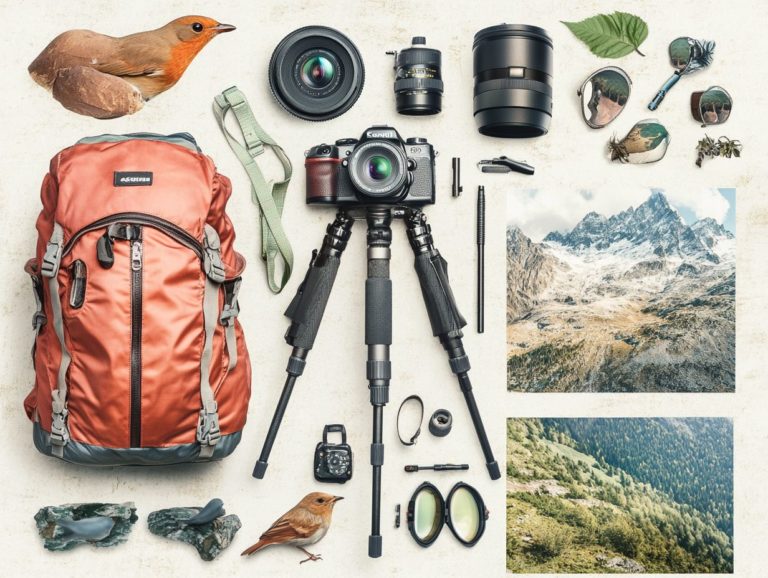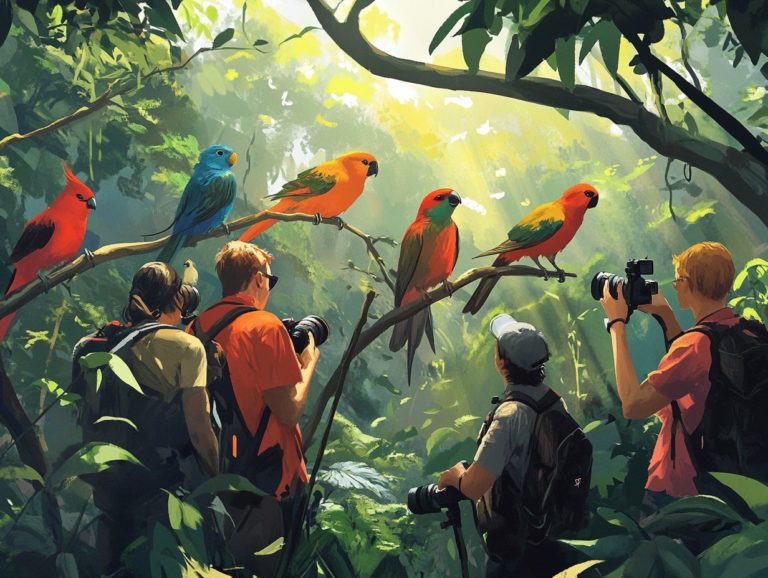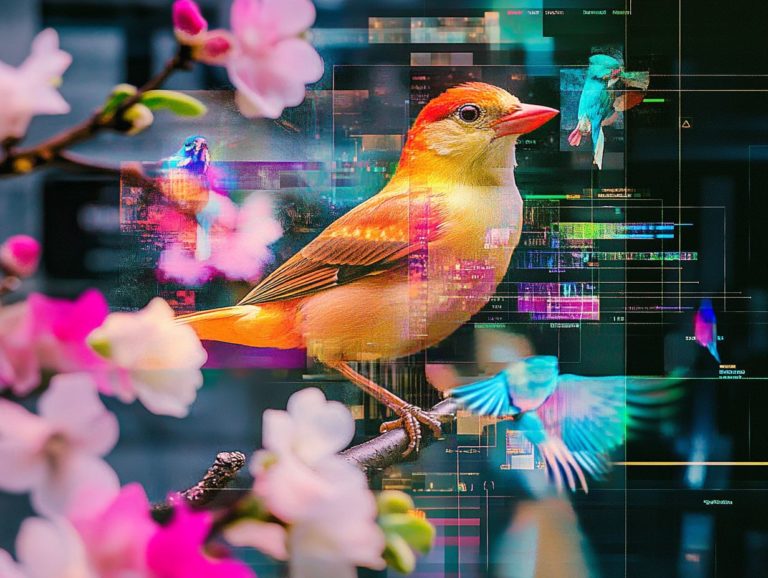How to Capture Bird Calls with Your Camera
Capturing the beauty of bird calls through photography presents a unique opportunity to connect with nature profoundly, especially when using tools like the Fujifilm X-T50 or Canon EOS R1.
This article explores the essential equipment you’ll need, from cameras such as the Fujifilm X-T50 and Canon EOS R5 Mark II to additional tools like directional microphones that enhance your results. It also offers effective techniques and tips for positioning, timing, and adjusting settings, ensuring you never miss a fleeting moment.
You will also learn how to edit and share stunning bird call images, allowing you to preserve the magic of those wild encounters.
Dive into the thrilling world of bird call photography today!
Contents
- Key Takeaways:
- Equipment Needed for Capturing Bird Calls
- Techniques for Capturing Bird Calls
- Tips for Successful Bird Call Photography
- Post-Processing and Sharing Bird Call Photos
- Frequently Asked Questions
- 1. How do I capture bird calls with my camera?
- 2. What camera settings should I use to capture bird calls?
- 3. How can I improve the audio quality of my bird call recordings?
- 4. What are some techniques for capturing bird calls with my camera?
- 5. Can I capture bird calls at any time of the day?
- 6. What should I do with my bird call recordings?
Key Takeaways:
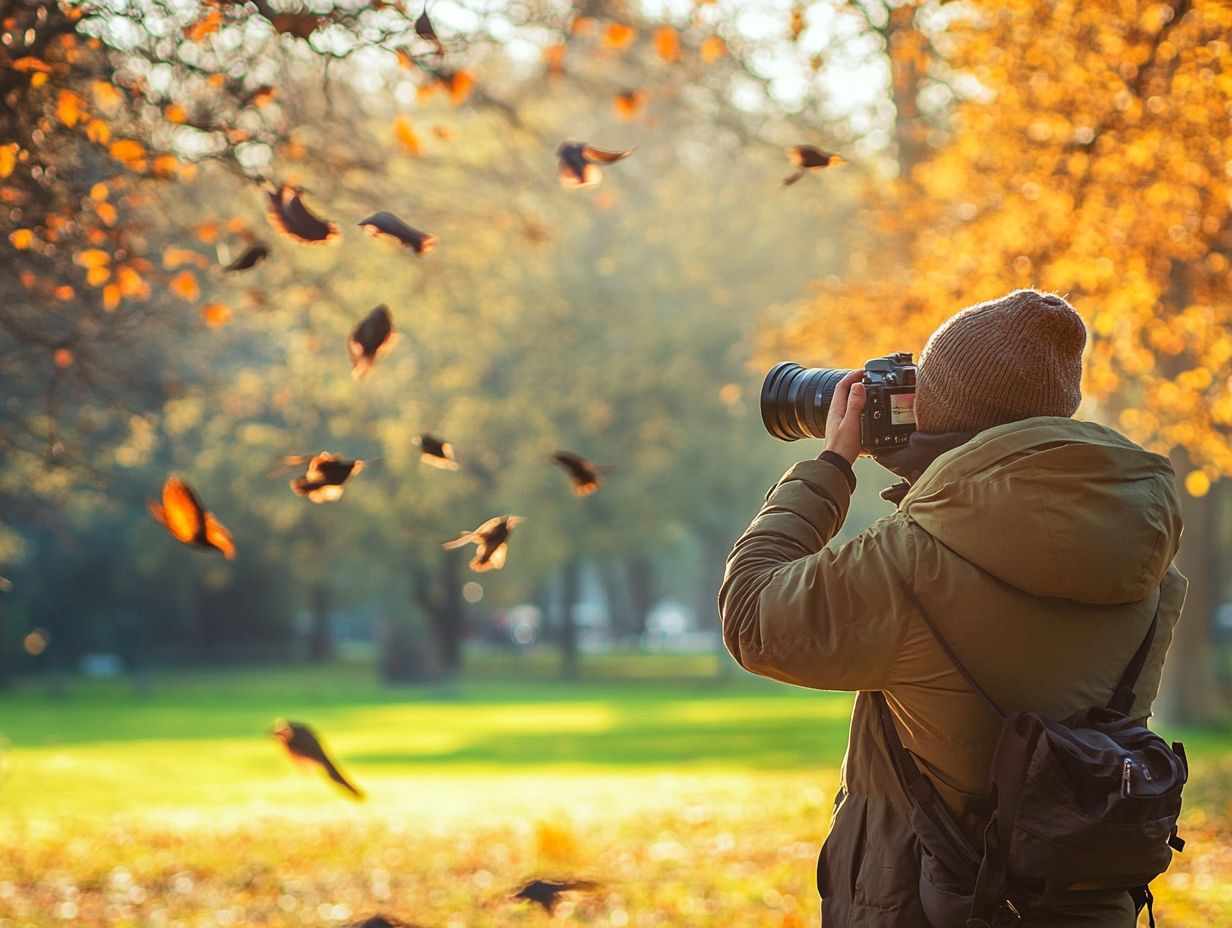
- Proper equipment is essential for capturing high-quality bird call photos. Ensure you have a camera and lens with the right capabilities, and consider using additional equipment for better results.
- Positioning and timing are crucial in photographing bird calls. Be aware of your surroundings and the bird’s behavior to capture the perfect shot. Adjust your camera settings to capture the sound and movement of the bird.
- Successful bird call photography requires patience. Choose a suitable location and environment, and be prepared to wait for the perfect moment. Edit and share your photos to showcase your work.
Why Photographing Bird Calls is Important
Bird calls are crucial for understanding and preserving wildlife, especially as unwanted sounds that can harm wildlife increasingly threaten the natural habitats of various bird species. Resources like the Macaulay Library and Cornell Lab of Ornithology document these threats.
By using high-quality audio recording tools, including the Sennheiser ME67 shotgun microphone and MixPre-3 II, you can record enchanting sounds in their natural context. This creates a rich auditory library that fulfills both educational and conservation goals, providing valuable insights into behavioral patterns, migration triggers, and the overall health of ecosystems.
As conservationists increasingly utilize this data, the impact on protective measures becomes more pronounced. This highlights the importance of preserving not only the visual splendor of birds but also their unique vocalizations. Each documented call educates the public and fuels ongoing conservation efforts, ensuring future generations can engage with and appreciate the vibrant chorus of the natural world.
Equipment Needed for Capturing Bird Calls
To effectively capture bird calls, you need a blend of high-quality visual and audio equipment. Consider investing in a reliable camera, such as the Fujifilm X-T50 or Canon EOS R5 Mark II, along with specialized microphones like the Sennheiser ME67. You can also enhance your experience by utilizing resources like learning bird calls with mobile technology.
Using an external microphone, like the Sennheiser ME67 shotgun microphone paired with a Rycote Softie windjammer, can significantly enhance your audio quality, enabling you to achieve detailed field recordings.
Additionally, portable audio recorders such as the MixPre-3 II and Zoom H4N Pro offer versatile recording options in WAV format, which are essential for preserving ambient sounds and minimizing handling noise.
Camera and Lens Requirements
When photographing bird calls, selecting the right camera and lens is crucial. A versatile mirrorless camera, like the Fujifilm X-T50 or Canon EOS R1, paired with the right lens can help you achieve high-resolution video and detailed stills.
Using top-notch equipment enhances your ability to capture fleeting moments in nature. Whether documenting a Northern Flicker or a Spotted Towhee, good gear makes a difference.
In the realm of bird photography, features like fast autofocus, high frame rates, and superior low-light performance are essential. Opting for a lens with a focal length of 300mm or more, like the Fujinon XF 100-400mm, can boost your chances of securing crisp, close-up shots without disturbing the wildlife.
Image stabilization is also vital for minimizing blur caused by hand shake, especially at slower shutter speeds. A lens with a wide aperture will allow for stunning background blur, making your subject pop against its natural surroundings. These features are critical for birdwatchers eager to craft captivating visual narratives.
Essential Audio Gear for Crystal-Clear Bird Calls
Along with a reliable camera, investing in the right audio equipment can dramatically enhance the quality of your bird call recordings. By utilizing directional microphones, you can minimize ambient noise and elevate audio clarity.
A thoughtfully arranged recording setup, complete with items like the Rycote Lyre Mount and over-the-ear headphones for real-time monitoring, will ensure you capture the best possible sound quality during your field recordings.
Exploring various microphone types, such as shotgun and lavalier microphones, allows you to customize your approach for different recording environments. Shotgun microphones are highly directional, while lavalier microphones are small and clip to clothing.
Don’t overlook accessories like windshields and boom poles; they are essential for reducing wind noise. Using a portable audio recorder like the Zoom H4N Pro or MixPre-3 II with high-resolution capabilities provides flexibility and convenience for effective fieldwork.
By integrating these tools and techniques, you can create captivating recordings that truly reflect the beauty of avian communication.
Techniques for Capturing Bird Calls
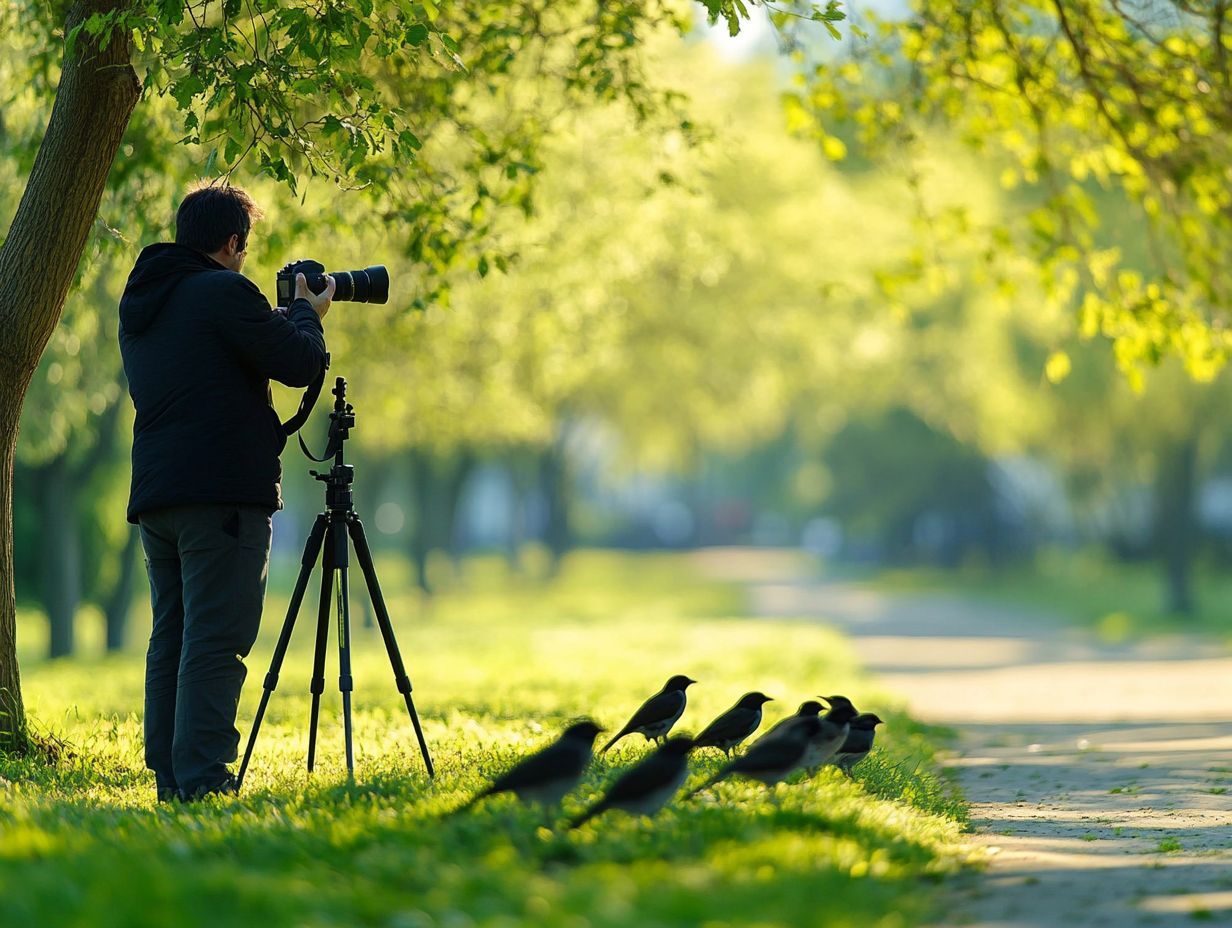
Mastering the art of capturing bird calls requires a range of techniques, particularly focusing on optimal positioning and timing. These elements are crucial for effectively recording the behaviors of different bird species.
By understanding the daily routines of birds, you can pinpoint the most opportune moments to set up your recording equipment. Whether equipped with a top-tier setup or simply using smartphone apps, this knowledge ensures you won’t miss any critical moments in the avian symphony.
Positioning and Timing
Effective positioning and timing play a pivotal role in bird call photography. By understanding the behavior of various bird species, you can identify the best locations and times to set up your equipment.
Knowing when a Western Bluebird is likely to call or discovering its ideal perch can make all the difference in capturing high-quality recordings, free from excessive ambient noise.
Observing migratory patterns can unveil peak periods for specific species, guiding you to visit locations brimming with avian activity. Choosing spots with natural barriers, like hills or dense foliage, can help minimize wind interference and enhance sound clarity.
Consider the environmental conditions; early mornings or evenings are often the most fruitful times when birds are most vocal. A deep understanding of local ecology and bird behavior will lead you to make more strategic choices, ultimately elevating the quality of your recordings significantly.
Adjusting Camera Settings
Adjusting camera settings on your Fujifilm X-T50 or any compatible mirrorless camera like Canon EOS R5 Mark II is essential for capturing high-resolution video and crisp images of bird calls, ensuring great audio preservation. The right settings can profoundly influence both audio quality and visual detail.
By optimizing your shutter speed, ISO (the sensitivity of your camera’s sensor to light), and aperture (the opening in the lens that controls light) according to lighting conditions, you can make your recordings clearer. This enhances your ability to document bird behavior with finesse.
For instance, a fast shutter speed is your best friend when it comes to freezing motion and minimizing blur absolutely crucial for capturing quick avian movements. A higher ISO setting lets you shoot in low-light conditions, but be wary: it can introduce noise that detracts from your audio capturing capabilities.
Don t overlook the aperture, either. A wider aperture can create a beautiful bokeh effect, effectively isolating birds from their backgrounds while letting in more light. These adjustments are vital for anyone looking to elevate their bird photography skills and craft stunning visual narratives that showcase unique characteristics of various species.
Tips for Successful Bird Call Photography
Bird call photography requires you to strike a delicate balance between location, environment, and your own mindset. The settings you choose can significantly enhance your chances of capturing those elusive calls.
Whether you re using an advanced recording setup or simply your smartphone for quick captures, understanding how different environments influence bird behavior is essential for effective documentation.
Location and Environment
The choice of location and a keen understanding of the environment are essential in bird call photography. Seek out areas with minimal sound pollution and rich biodiversity to capture both clear audio and breathtaking visuals. Factors like water bodies, dense foliage, or open fields can greatly influence bird behavior and call frequency.
Moving beyond just the visuals, selecting habitats such as wetlands, forests, or grasslands can profoundly impact the species you encounter and their vocalizations. Wetlands tend to attract waterfowl and other species that thrive near water, while woodlands may host songbirds that fill the air with a symphony of calls at dawn.
Understanding seasonal changes is equally crucial; certain areas may burst with life during spring migrations, providing unique opportunities to capture vibrant interactions. By being attuned to these factors, you not only elevate the quality of your bird photography but also deepen your appreciation for the natural world around you.
Patience and Persistence
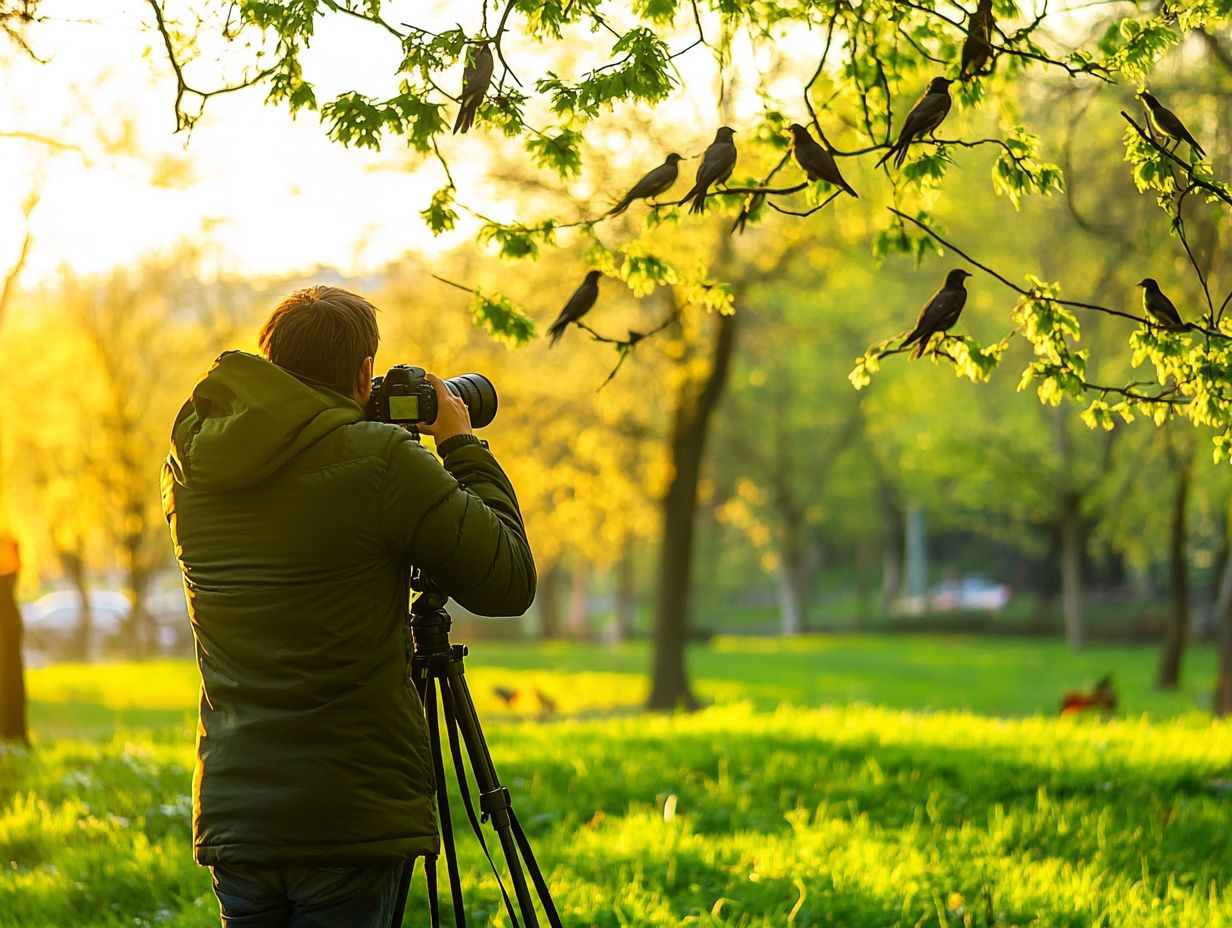
In the world of bird call photography, your success hinges on patience and persistence. Often, capturing those elusive perfect moments means spending long hours immersed in nature. Whether you’re using sophisticated equipment or smartphone apps, staying alert and adapting to shifting conditions can yield remarkable results, making every effort a worthwhile endeavor.
Imagine yourself spending hours at dawn, quietly observing the behavior of a particular bird species. That serene waiting could reward you with the perfect shot or an enchanting audio capture of a rare bird call. Get outside and start capturing!
Your routine, which includes regular outings, helps you familiarize yourself with the peak activity times for various species. Over time, the insights gained from this dedication not only sharpen your technical skills but also deepen your connection to the natural world, leading to stunning photographs and unforgettable auditory experiences.
Post-Processing and Sharing Bird Call Photos
Once you’ve captured those breathtaking images and recordings of bird calls, this is your chance to bring your work to life through post-processing. This stage allows you to refine and enhance your work for sharing and preservation.
By utilizing advanced editing software, you can improve audio quality and elevate high-resolution video visuals. This meticulous attention to detail ensures that your recordings maintain their clarity and impact, making a lasting impression when shared with communities or conservation groups.
Editing and Enhancing Images
Editing and enhancing the images you’ve captured during bird call photography is crucial for showcasing your work at its finest. Using software designed for photographers can elevate both the visual details and the sound quality of your captures.
Whether you re refining high-resolution video or adjusting images for improved clarity, these methods can transform your efforts into professional-grade documentation. Various editing techniques not only enhance the visual allure but also ensure that the sounds resonate with clarity.
For your images, tools like Adobe Lightroom and Photoshop offer extensive features for fine-tuning color balance, exposure, and sharpness. These tools allow you to enhance even the most intricate details seamlessly.
On the audio front, programs such as Audacity and Adobe Audition let you eliminate background noise, adjust levels, and apply filters. This ensures that the delicate sounds of avian communication are preserved and highlighted. Mastering these tools can significantly enrich the overall quality of your projects.
Sharing and Preserving Your Work
Sharing and preserving your bird call photography goes beyond simple documentation; it plays a crucial role in broader conservation efforts by providing invaluable data on various bird species. Platforms such as the Macaulay Library and eBird checklists enable you to share your findings, contributing to research and fostering community engagement in bird conservation.
These initiatives enhance scientific understanding and empower you and your local community to actively participate in wildlife observation. By uploading your recordings and images, you can track migration patterns, identify shifting habitats, and monitor population trends over time.
Social media platforms like Instagram and Facebook are essential tools for reaching a wider audience and generating awareness about the challenges faced by certain species. Engaging in forums and citizen science projects helps bridge the gap between amateur birdwatchers and professional researchers, forging a collaborative approach toward biodiversity preservation.
When you share, you re making a real impact on our understanding of birds, enriching the collective knowledge base and catalyzing informed actions for the future of avian species.
Frequently Asked Questions
1. How do I capture bird calls with my camera?
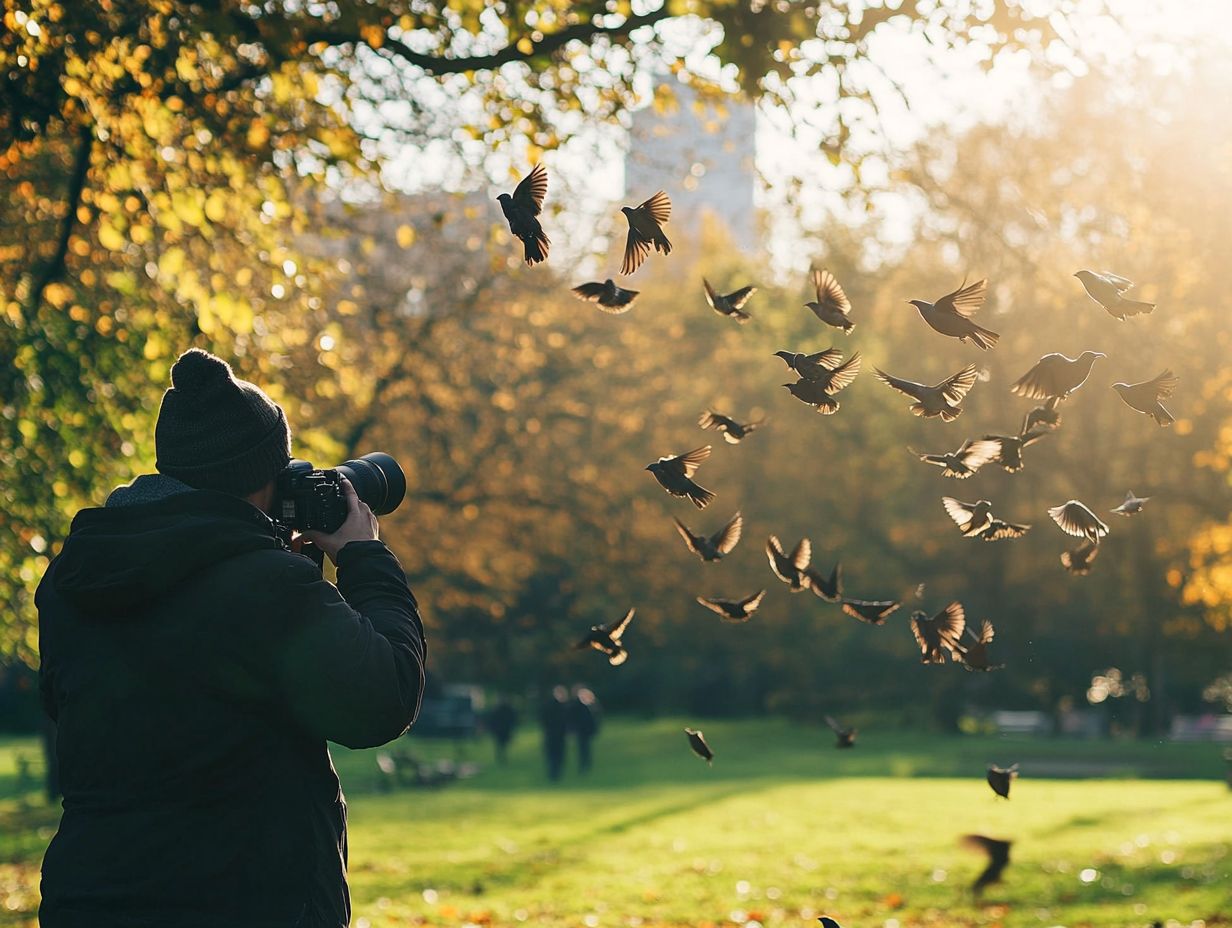
To capture bird calls with your camera, you need a camera or smartphone with a video recording function. Find a quiet and peaceful spot outdoors where you are likely to hear birds. Once you hear a bird call, aim your camera in the direction of the sound and press the record button to capture it. For more detailed techniques, check out this guide on how to record bird sounds effectively.
2. What camera settings should I use to capture bird calls?
The best camera settings for capturing bird calls may vary depending on the type of camera you are using. However, some general recommendations include using a high shutter speed to freeze the motion of the bird, setting the focus to manual, and using a low ISO to reduce noise in the video.
3. How can I improve the audio quality of my bird call recordings?
To improve the audio quality of your bird call recordings, consider using an external microphone or a smartphone app designed specifically for recording bird calls. These tools can help capture and amplify the sound of the bird calls, making them clearer and more enjoyable to listen to.
4. What are some techniques for capturing bird calls with my camera?
One technique is to use the zoom function on your camera to get a closer view of the bird without disturbing it. Using a tripod keeps your camera steady, so your recordings are smooth. Try different camera angles and positions to capture unique perspectives of the bird calls.
5. Can I capture bird calls at any time of the day?
Yes, you can capture bird calls at any time of day. However, the best times are early morning or late afternoon when birds are most active. Research the specific types of birds you want to capture, as they may have particular times of day when they are more vocal.
6. What should I do with my bird call recordings?
You can use your bird call recordings in many ways. Some people listen to them to relax or meditate.
Others use them to learn about different bird species. You can share your recordings with fellow bird watchers or create nature-themed content.
Imagine relaxing to the calming sounds of bird calls! Start recording today and explore the amazing world of birds!

